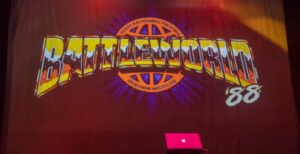 Theatre allows us to experience that which is intolerable. It allows us to walk through the flames of events that arrest, disrupt and sometimes shatter lives and to come out the other side unscathed. In this way we can glimpse the spectrum of human experience entirely from Othello’s jealousy to the grief of Hecuba. If you are like me and get your news between three sips of coffee, phrases like ‘stress positions’ don’t get the time and attention they need to sink in. The gift of Eyes of the Enemy is to bring us one step closer towards comprehending headlines like “Canadian tortured in Mauritanian prison, says Amnesty”(CBC Jun 25,2013). The now familiar double face of the Internet is its ability to connect and disconnect us from the world. Reading about the pain felt by strangers on the other side of the planet in less than two hundred words before clicking on the kitten memes drains the news story of impact. Well what better way is there to regain some meaning than some in yer face?
Eyes of the Enemy centres on the interrogation of Jack, a man who may have information regarding expected attacks of soldiers in Afghanistan; the story resounds with unsettling parallels to the case of tortured Canadian citizen, Maher Arar. It would be impossible for the play to be non-political, however the politics inherent in the script are far from the focus. The struggle for the characters is trying to find and do what is right. Yet structurally, the ‘stepping out of the room’ device and the intensification of the means of interrogation focus the dramatic attention on the action of torture itself. It almost felt like a ‘how to’ guide. Like a camera passing over the surgery tools in a horror movie, descriptions of the next technique primed us for the upcoming scene. I began to wonder at what point horror became torture porn. I should be upfront in recommending this show; it is not for the feint of heart. If the thought of cuffs and hoods makes you squeamish, sit this one out. My hat is off to Evan Hall and Chris Cook for safely executing the wince-inducing blocking. There is a fine line between believable violence on stage and doing damage to yourself or partner. Even at its most harrowing, I felt free to imagine that the action was real rather than worry that it was real.
While I was watching some of these scenes I couldn’t help but think of the infamous Milgram experiment (where participants carried out simulated torture as long as an authority demanded it) and suddenly felt my own complicity in the act. A silent audience allows the action to continue. Perhaps a silent public damns people just the same. The beautiful/terrible thing about mirror neurons is I got to identify with the victim and, in silent complicity, with the perpetrator. This act is being done for us, in our name. Yet it is abhorrent to us. The relationship of torturer-tortured was once summarized to me thus: “You are vulnerable. I am in control. You are in pain. I am at ease.” Watching the opening scene as Jack dresses and puts himself together, I felt the unsettling knowledge that he would soon be a mess on the floor and that I would watch his slide.
So why would you go? Why take part in this if the only choice you’re given is to become the victim or the victimizer?
You go because Eye of the Enemy is not a dialectic between two sides. The show is less about the choosing of sides in the ‘ticking time bomb’ scenario and more about defining the terms. It’s more about putting coated semantic phrases in real space. If we are going to talk about it (and we should) let’s make sure we have at least an iota of an idea of what ‘interrogation techniques’ means. It’s about bringing us closer to a (perhaps impossible) comprehension of the intolerable.
Theatre allows us to experience that which is intolerable. It allows us to walk through the flames of events that arrest, disrupt and sometimes shatter lives and to come out the other side unscathed. In this way we can glimpse the spectrum of human experience entirely from Othello’s jealousy to the grief of Hecuba. If you are like me and get your news between three sips of coffee, phrases like ‘stress positions’ don’t get the time and attention they need to sink in. The gift of Eyes of the Enemy is to bring us one step closer towards comprehending headlines like “Canadian tortured in Mauritanian prison, says Amnesty”(CBC Jun 25,2013). The now familiar double face of the Internet is its ability to connect and disconnect us from the world. Reading about the pain felt by strangers on the other side of the planet in less than two hundred words before clicking on the kitten memes drains the news story of impact. Well what better way is there to regain some meaning than some in yer face?
Eyes of the Enemy centres on the interrogation of Jack, a man who may have information regarding expected attacks of soldiers in Afghanistan; the story resounds with unsettling parallels to the case of tortured Canadian citizen, Maher Arar. It would be impossible for the play to be non-political, however the politics inherent in the script are far from the focus. The struggle for the characters is trying to find and do what is right. Yet structurally, the ‘stepping out of the room’ device and the intensification of the means of interrogation focus the dramatic attention on the action of torture itself. It almost felt like a ‘how to’ guide. Like a camera passing over the surgery tools in a horror movie, descriptions of the next technique primed us for the upcoming scene. I began to wonder at what point horror became torture porn. I should be upfront in recommending this show; it is not for the feint of heart. If the thought of cuffs and hoods makes you squeamish, sit this one out. My hat is off to Evan Hall and Chris Cook for safely executing the wince-inducing blocking. There is a fine line between believable violence on stage and doing damage to yourself or partner. Even at its most harrowing, I felt free to imagine that the action was real rather than worry that it was real.
While I was watching some of these scenes I couldn’t help but think of the infamous Milgram experiment (where participants carried out simulated torture as long as an authority demanded it) and suddenly felt my own complicity in the act. A silent audience allows the action to continue. Perhaps a silent public damns people just the same. The beautiful/terrible thing about mirror neurons is I got to identify with the victim and, in silent complicity, with the perpetrator. This act is being done for us, in our name. Yet it is abhorrent to us. The relationship of torturer-tortured was once summarized to me thus: “You are vulnerable. I am in control. You are in pain. I am at ease.” Watching the opening scene as Jack dresses and puts himself together, I felt the unsettling knowledge that he would soon be a mess on the floor and that I would watch his slide.
So why would you go? Why take part in this if the only choice you’re given is to become the victim or the victimizer?
You go because Eye of the Enemy is not a dialectic between two sides. The show is less about the choosing of sides in the ‘ticking time bomb’ scenario and more about defining the terms. It’s more about putting coated semantic phrases in real space. If we are going to talk about it (and we should) let’s make sure we have at least an iota of an idea of what ‘interrogation techniques’ means. It’s about bringing us closer to a (perhaps impossible) comprehension of the intolerable. 








